Review
English_[66 years after the Korean War] How they reconstructed the town in Deokjeokdo Island
- WRITER유매
- DATE2016.07.06
- COUNT1275
[66 years after the Korean War]
How they reconstructed the town in Deokjeokdo Island
The Korean War stopped in 1953 when the armistice agreement was signed. The war lasted three years and one month. Only the homeless refugees were left after the war stopped. They dispersed into every country to find new homes, and worked together to reconstruct the town.
In 1954, 6749 refugees gathered in Deokjeokdo Island located in the coastal waters of Incheon. The refugees outnumbered the natives of Deokjeokdo Island (6039) and most of them came from Hwanghae Province during the Korean War. A newly appointed Catholic priest and the village people reconstructed the town gradually. I was wondering if the people of Deokjeokdo Island still remember those days. I caught the ferry to Deokjeokdo Island on 25th of June, the day Korean War started 66 years ago.
The power of cooperation that carried electric poles to brighten the town in Deokjeokdo Island in the days when there was no electricity
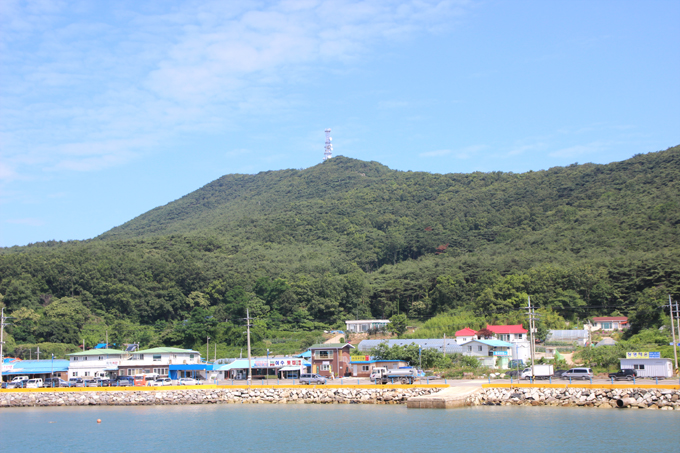
▲Whole view of the town in Deokjeokdo Island
The weather was fine on my way to the Deokjeokdo Island. Seagulls were flying around the prow cleaving through the water. The ferry arrived at Deokjeokdo Island with a warm welcome of seagulls and lots of tourists got off the ferry.
The peak which can be seen straight from the dock is called Bijo Peak, the second highest peak(292m) in Deokjeokdo Island. The Bijo Peak hiking course is especially popular for its various sceneries of trees and rocks. When you stand in the summit of the peak where solemn view that amazes the eyes spreads, the small and big islands of Incheon Sea will be seen in one glance.
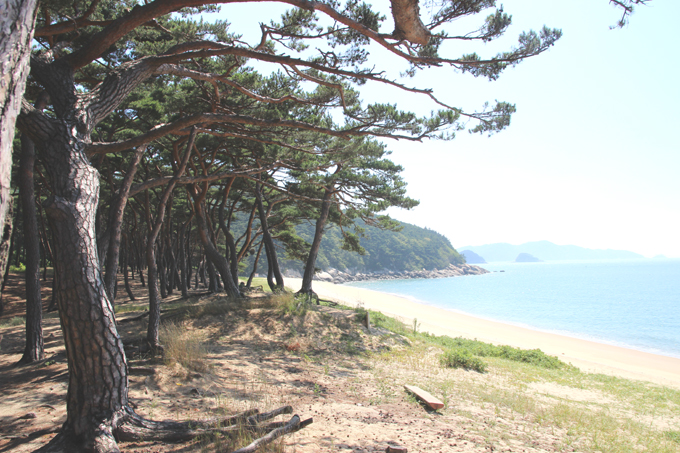
▲Batjirum Beach
Batjirum Beach which is 3km away from the dock. Bijo Peak forms the background of the beach while endless horizon over the sea creates breath-taking scenery. Fine, clean and golden sandy beach is in a great harmony with hundreds year of 600 black pine trees and sea briers.
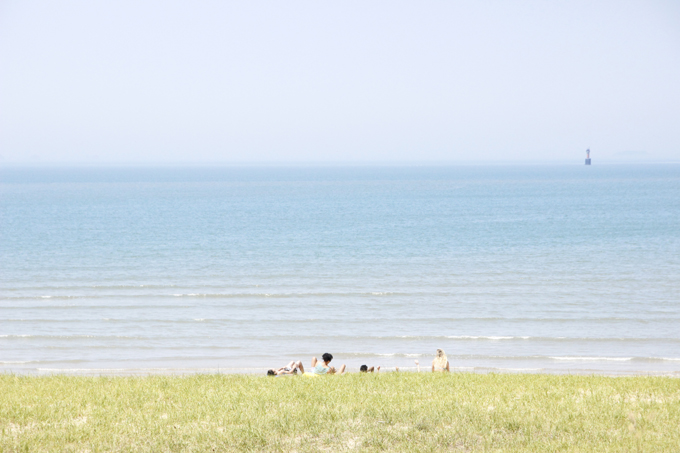
▲Seopori Beach 西浦里海滨浴场
Representative beach of Deokjeokdo Island where you can see a clear turquoise sea. The sun in the sky shines above the dense pine trees, and the ocean waves sound faintly. You can have fun in the water and enjoy camping as well.
There are three trails leading to the Bijo Peak. Batjirum Beach, Jinri Catholic church, and Seopori Beach are the starting points of the trails. I chose Seopori Beach. The trail smelt strongly of pine trees. An hour was enough to reach the Bijo Peak. However, you have to be aware that hiking will start from the sea level(0m). Therefore, you have to climb 300m entirely. I was running with sweat in the early summer.
"Is it strenuous? We crossed this tough mountain from side to side several times carrying a sack of cement in the old days. It was around 10 years after the Korean Was has stopped."
I met Mr. Seo, a resident of Seopori town and one of the people who have observed the reconstruction of the towns in Deokjeokdo Island, on my way back down from the Bijo Peak. He was born and bred here, and he still remembered the moment that Deokjeokdo Island was crowded with the flood of refugees. He started his talking about Bundo Choi, an American priest who came to Deokjeokdo Island in 1962. Mr. Choi helped the weak regardless of their religion and played the pivotal role in laying a solid foundation. Mr. Seo helped Mr. Choi reconstructing the town.
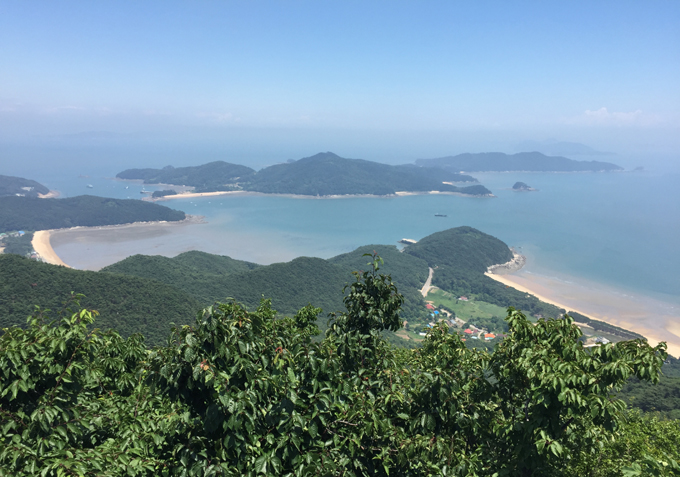
▲Deokjeok Islands seen from the Bijo Peak
Bijo Peak(292m), the second highest peak after the Guksu Peak(313m). The small and big islands of Incheon Sea including Deokjeok Islands will be seen in one glance.
The priest bought electric generators at the U.S. army base in Busan. One day, I was woken up by burr sound at daybreak and found out a ship arrived with the generators. Nowadays, we have excavators, but all the people in town had to pull the rope all day long to carry the generators at that time. That's how we got the two generators and brought the electricity to the town for the first time."
It was 10 years after the Korean War, and the people in town were still suffering from lack of houses and food. Needless to say, infrastructures like electricity and water supply were nonexistent at that time. Moreover, there were not nearly enough supplies and resources compared to inland areas since the towns in an island were far away from inland areas. Reconstruction gained momentum as the electricity became available in a small town of Deokjeokdo Island.
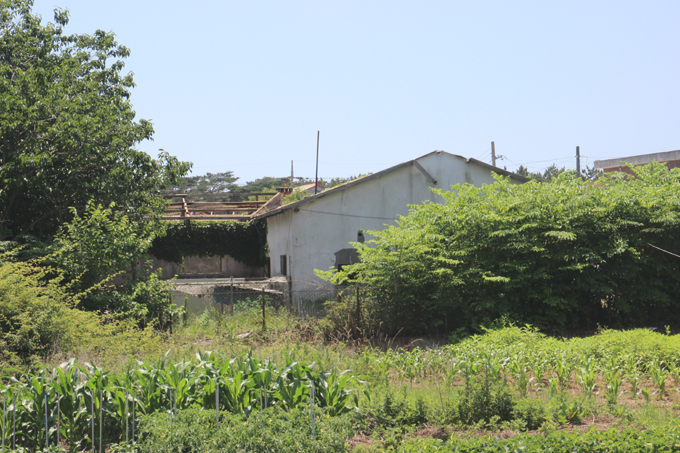
▲Power plant site of Seopori
As the electricity became available in Seopori, the news spread to the people of Jinri town and Bukri town. As the people of both towns asked to share the electricity, the people of Seopori town rolled up their sleeves to help their neighbor. They bought iron and cement for themselves and made rectangular shaped electric poles. A few electric poles made at that time are still standing in towns.
The priest and the people carried the electric poles to the next town by themselves. They erected the electric poles from Seopori to Bukri which is located on the other side of the mountain, and the electricity became available gradually in all towns including Jinri. One day, people were so hungry and picked some fruit while they were carrying the electric poles. Now that I think about it, the fruit was Korean wild grapes. When Korean wild grapes ripen, they turn into black. But the priest thought red grapes were ripe ones, so he ate them and got surprised by bitter taste. He asked 'How do you eat these bitter ones?', and everyone laughed."
Electricity was supplied from dusk time to midnight and at rise of sun, twice a day. The priest and the people organized electric association, and the head of Deokjeok town was appointed as the representative. Figures from the Ministry of Home Affairs show that 592kw of electricity was supplied to 850 houses in Deokjeokdo Island by private generation in 1972.
10 years of reclamation, dug the ground and established water supply by themselves
Many tourists come to Deokjeokdo Island wearing alpine clothing, but bringing a change of clothes is highly recommended since having fun in the water after the mountain climbing is one of the biggest pleasures in a trip to Deokjeokdo Island. There are five famous beaches in Deokjeokdo Island, and Neungdong gravel yard is known for its unique pebbles.
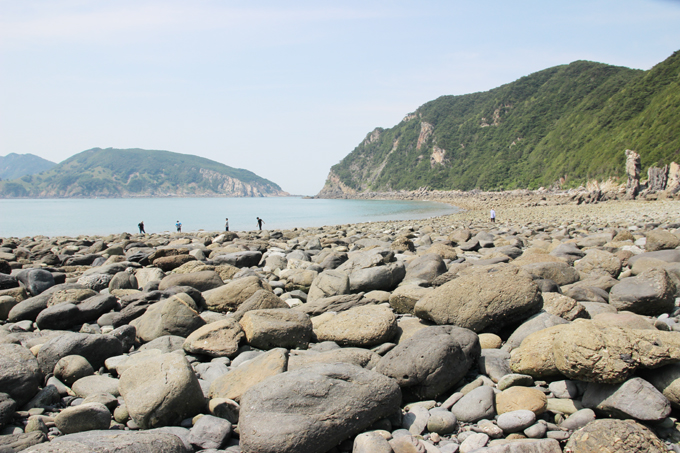
▲Neungdong gravel yard
Neungdong gravel yard is located in northwestern Deokjeokdo Island and famous for strange rocks and bizarre stones. You can enjoy sea bathing, fishing, a rosy sky at sunset and glow of the setting sun dying the sea red.
Neungdong gravel yard is the unique beach of Deokjeokdo Island, formed with pebbles small and big singing whenever waves hit. Admiring the scenery of wave lapping makes me to lose count of time. You can also repeatedly find the distinctive stone towers carrying the individuality of the tourists.
Moving toward the south following the road on the right side of Neungdong gravel yard will lead you to Seopori. A large-scale land reclamation project started here in 1962. What is more surprising is that residents of Deokjeokdo Island reclaimed the most of the land which is 900,000m² wide. The reclamation project lasted almost 10 years.
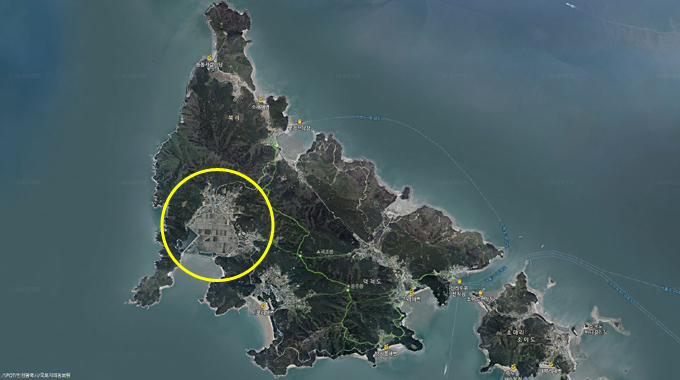
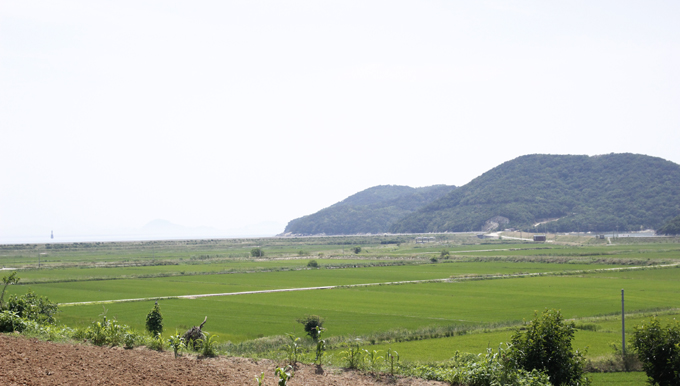
▲Whole view of Seopori reclamation area
You can imagine how large the scale of reclamation was when you see the map above.
10 years after the Korean War, the problem at hand of Deokjeokdo Island was the lack of food and drinking water. Mr. Bundo Choi, priest of Deokjeokdo Island, received the support from Catholic Church in 1962 and built a dike. He gave flour to the people who participated in the reclamation project. Giving flour to the people for free could have solved the problem of hunger, but Mr. Choi expected to establish the food supply and demand system. And he intended to let people know the importance of working.
After the reclamation project ended, 900,000m² of farmland became available, and one third of annual output of Deokjeokdo Island had been increased. Neatly organized farmland of the satellite map is the result of this period. Reclamation project of Seopori had been 90% completed and transferred to the government in 1971.
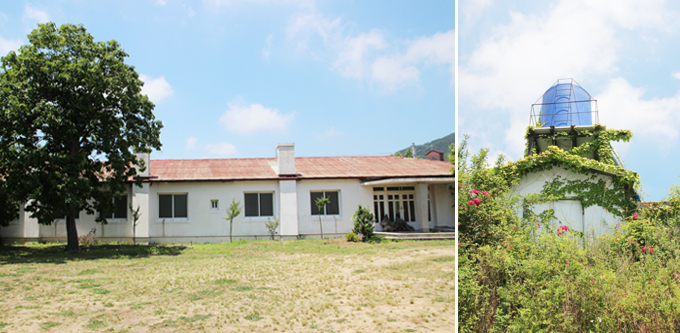
▲Blessed Peter Yoo hospital site built by Priest Bundo Choi(left), water supply facilities of the old convent
Drinking water was another thing to get through. People need the help of a water-bearer to get the drinking water in those days. It took an hour or two to bear water from house to house in Deokjeokdo Island. The water-bearer had a really hard time in winter. Priest Bundo Choi received help from the seminary student of the Seoul diocese and dug the ground to lay water pipes with the villagers.
When we look back the reconstruction history of Deokjeokdo Island, we can find out that Priest Bundo Choi's name is often mentioned since he played the pivotal role. He also helped the people of Yeonpyeong and Deokjeok learn to raise spores so that they could start laver farming. He was awarded Camellia Medal by the government in June 1971 and left Deokjeokdo Island in 1976 since he was assigned to the Catholic Church in Songhyeondong.
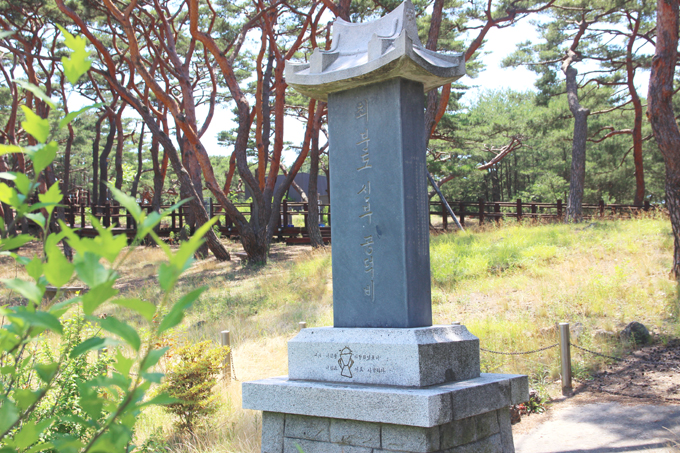
▲Memorial Stone for Priest Bundo Choi
People of Deokjeokdo Island had formed a village community based on trust and cooperation for 20~30 years after the Korean War. Their story about Economic cooperation as well as active reconstruction has been handed down by tradition until now for about 50 years.
Mr. Song who runs a guest house at Seopori emphasized that "Story about reconstruction of Deokjeokdo Island is the one that every person here in Deokjeokdo Island knows and should know."
There were more than 20,000 residents in the old days, but around 500 people are living in Deokjeokdo Island now. Two out of ten people are the natives, and most of the others are the elder people who came from Hwanghae Province after the Korean War. Five northwestern islands in the West Sea are close to North Korea and we think the threat of war still exists. However, establishing the infrastructure facilities together after the Korean War is the priceless memory that our children should remember."
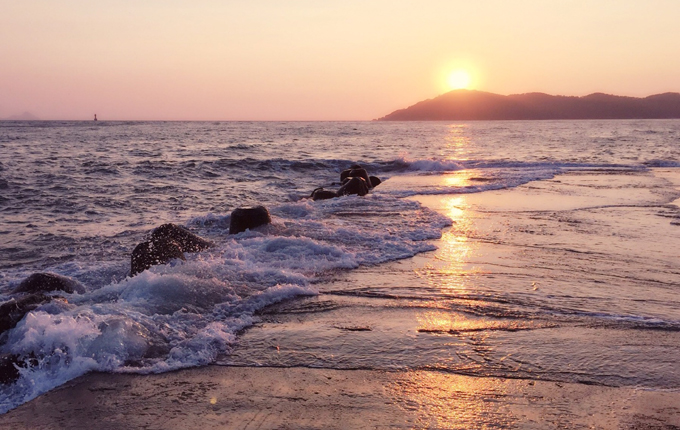
▲Sunset at Deokjeokdo Island
West Sea is famous for its beautiful sunset, but watching the sunset at Seopori Beach and Neungdong gravel yard is a must-see scenery. What about making a romantic memory of sunset that crimsons the sea and the sky in Neungdong gravel yards this vacation?
Deokjeok Islands, 40 inhabited and uninhabited islands in the coastal waters of Incheon, are called 'Stars on a sea'. If you look down Deokjeok Islands from the sky they look like stars on a sea, and that's how Deokjeok Islands got the nickname. Deokjeokdo Island is the biggest one among this star group. Will Deokjeokdo Island be forgotten as time goes by? Probably this shining town in Deokjeokdo Island will be remembered for ages. People will not forget this invaluable reconstruction history more than any others even though it is not the greatest one.
There are two ways to get to
Deokjeokdo Island by ship.
|
Reference
Ministry of Home Affairs, Island area report (1972)
YongGu Kim, Story about the islands in Incheon which you did not know (2016)
유매
2016.07.06
comment
- tistory
- naver
- daum
- Operation rules
- We have several rules that is needed to maintain a good community. If we have determined that you have written an article that violate the rules, then we do not notify you, and immediately we can delete the article.
- Criteria to delete the post.
-
- The act of spreading private information (name, company name, private photos, phone number, Social Security Number, etc) or continuing to write a great number of post or comments.
- Posts to blame or insults others.
- Pornography posts or inappropriate posts for the youth.
- Posts that is different from the service purpose.
- Defamatory posts, such as to blame others or to spread false information.
- Posts that violate the relevant law such as Copyright Violation.




